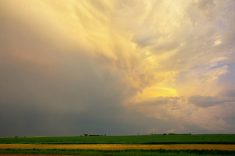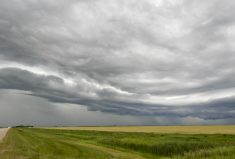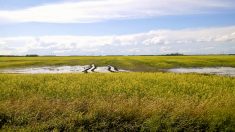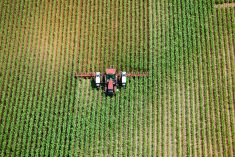The dry edible bean crop in North Dakota is shaping up well, according to Tom Kennelly, president of Northarvest Bean Growers Association.
“But there are spots that got adequate moisture and there are still spots that are waiting on timely rains,” he said, from his farm near Grafton, N.D.
North Dakota is by far the largest bean-growing state in the U.S. with about 32 per cent of the crop. Michigan is second at 17 per cent and Nebraska grows the third most at 11 per cent.
Read Also

Defence investments could benefit agriculture
A bump in Canada’s NATO spending commitments could lead to infrastructure investments that would benefit rural areas
“We’ve been extremely warm and it screws up our moisture a little bit faster,” he said.
During the last couple weeks, Kennelly said temperatures in his area have soared, reaching past 30 C some days, with high humidity.
“But it’s hard to say if it’s a bumper crop or a failure. A week or 10 days can make or break you. Right now, I think we’re fair.”
The United States Department of Agriculture reported in June that seeded acreage for edible beans for 2018 was 1.834 million acres. In North Dakota, farmers planted 550,000 acres. That compares to 2.092 million acres nationally and 705,000 North Dakota acres in 2017.
Kennelly said the reduced acres were expected given the difficult conditions last year, when drought parched crops in much of the state.
Even though growers still managed to harvest a decent crop in 2017 at 7.38 million hundredweight, that was down from 12.263 million cwt. the previous year.
“I think a lot of guys just tend to think we need more moisture than we do at times and I think that is what surprised us last year,” Kennelly said.
The dry weather limited disease pressure, such as white mould, he said. The decent crop was also a credit to the upright varieties now available and growers, who are more informed on making sure crops receive timely spray applications.
Kennelly attributed the reduced acreage this year to some growers who might have been turned off beans because of what he called the “games played at harvest time” with too much dockage being assessed to deliveries.
He acknowledged the dry year probably contributed to the dockage problem, but many growers shifted to wheat and soybeans where they don’t have to deal with those issues.
As well, he said some growers, depending on their situations and location, might find that pricing beans at 22 to 25 U.S. cents per pound on contract, is only break-even and many will turn to soybeans or wheat because they are simpler.
As 2018 progresses, he expects edible bean prices to pick up, depending on consumption patterns and how the current trade issues play out.
“I think that this might be the year when the contracts should be the bottom and I would think the prices should be up from that.”
No matter how the current trade issues between the U.S. and China and the U.S. and other countries work out, somebody will always be looking to source what they want, no matter the tariffs, he said.
“There’s only so many beans that are in the market and somehow or another, people find what they want.”














